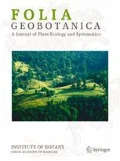Abstract
Calamagrostis villosa stands occurring in areas deforested by air-pollution impact in the Moravian-Silesian Beskydy Mountains were characterized by a high dry mass of total underground biomass (3 300 g. m−2—the slope site, 2 850 g. m−2—the flat site). The percentage of living roots and rhizomes in total underground biomass was very high (about 70%). The total aboveground biomass was respectively, 321 g.m−2 (the slope site) and 726 g. m−2 (the flat site). In unstabilized habitats on steep slope, the higher plant biomass produced was allocated to a more developed root system.
Literature Cited
Bittner T. (1985): Průběh zakyselení půdního prostředí na pasekách v imisní oblasti Bes kyd.—Ms. [Dipl. práce; depon. in: Knih. VŠZ, Brno].
Samek V. (1988): Expanze třtiny chloupkaté v imisních oblastech hor—Živa, Praha, 36: 45–46.
Tesařová, M., Fiala K. etStudený V. (1982): Live and dead roots—their mass ratio in several grassland stands.—Folia Geobot. Phytotax., Praha, 17: 427–430.
Author information
Authors and Affiliations
Rights and permissions
About this article
Cite this article
Fiala, K., Jakrlová, J. & Zeilená, V. Biomass partitioning in twoCalamagrostis villosa stands on deforested sites. Folia geobot. phytotax. 24, 207–210 (1989). https://doi.org/10.1007/BF02853042
Received:
Issue Date:
DOI: https://doi.org/10.1007/BF02853042

